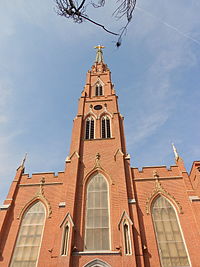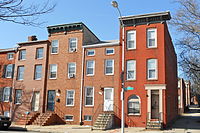The history of Lithuanians in Baltimore dates back to the mid-19th century. Thousands of Lithuanians immigrated to Baltimore between the 1880s and 1920s. The Lithuanian American community was mainly centered in what is now the Hollins–Roundhouse Historic District. Baltimore's Lithuanian community has founded several institutions to preserve the Lithuanian heritage of the city, including a Roman Catholic parish, a cultural festival, a dance hall, and a yeshiva.
Demographics

In 1920, 2,554 foreign-born White people in Baltimore spoke either the Lithuanian language or the Latvian language.
In 1940, 2,839 immigrants from Lithuania lived in Baltimore. These immigrants comprised 4.7% of the city's foreign-born white population.
In the 1960 United States Census, Lithuanian-Americans comprised 44% of the foreign-born population in South Baltimore's tract 22–2.
By 1991, there were an estimated 20,000 Lithuanians living in the Baltimore area.
The Lithuanian community in the Baltimore metropolitan area numbered 11,024 as of 2000, making up 0.4% of the area's population. In the same year Baltimore city's Lithuanian population was 1,519, 0.2% of the city's population.
In 2013, an estimated 1,092 Lithuanian-Americans resided in Baltimore city, 0.2% of the population. As of September 2014, immigrants from Lithuania were the 102nd largest foreign-born population in Baltimore.
History

Lithuanians began to settle in Baltimore in 1876. The wave increased greatly during the 1880s and continued in large numbers until the 1920s. By 1950, the Lithuanian community numbered around 9,000. These Lithuanians settled primarily in a neighborhood north of Hollins Street that became known as Baltimore's Little Lithuania.
In 1889, Jonas Šliūpas founded the Lithuanian Scientific Society in Baltimore. It promoted Lithuanian language and culture and was active until 1896.
Three Roman Catholic churches have been designated as Lithuanian parishes: St. Alphonsus' beginning in 1917, St. John the Baptist Church from 1888 to 1917, and St. Wenceslaus beginning in 1872. St. Alphonsus' is the only remaining Lithuanian parish in Baltimore, as St. Wenceslaus was re-designated as a Bohemian parish and St. John the Baptist Church closed in 1989.
While most Lithuanians who settled in Baltimore were Roman Catholic, a large minority were Lithuanian Jews. Between the 1880s and the 1920s, Lithuanian Jews (also known as Litvaks) were a major component of Jewish immigration to Baltimore. The Yeshivas Ner Yisroel, a prominent yeshiva in Baltimore, was founded as a Lithuanian (Litvish)-style Talmudic college by Jews from Lithuania and Belarus. Litvaks also helped found the B'nai Israel Synagogue.
Little Lithuania

From the 1880s to the 1920s, the Hollins-Roundhouse neighborhood became established as the center of Baltimore's Lithuanian immigrant community. Because of the large Lithuanian population in the area north of Hollins Street, the area became known as Little Lithuania. A few remnants of the neighborhood's Lithuanian heritage still remain, such as Lithuanian Hall located on Hollins Street.
Culture

While other immigrant ethnic groups in Baltimore founded numerous ethnic building and loan associations between the 1860s and the 1910s, Lithuanians only founded one. This is because many Lithuanians shared the associations of other ethnic groups, especially those of the Polish.
An annual Lithuanian Festival is held in Catonsville in Baltimore County, not far outside city limits. The festival features Lithuanian food and drink, dances, and ethnic items.
Notable Lithuanian-Americans from Baltimore

- Albert Blumberg, a philosopher and political activist who was an official of the Communist Party for several years before joining the Democratic Party as a district leader.
- Philip Glass, a composer considered one of the most influential music makers of the late 20th century.
- Yaakov Kamenetsky, a prominent rosh yeshiva, posek and Talmudist.
- Yaakov Yitzchok Ruderman, a prominent Talmudic scholar and rabbi who founded and served as rosh yeshiva (yeshiva head) of Yeshiva Ner Yisroel in Baltimore.
- Eli Siegel, the poet, critic, and educator who founded Aesthetic Realism.
- Anne K. Strasdauskas, a law enforcement official who served as sheriff of Baltimore County from 1998 until 2002.
- Johnny Unitas, a professional football player who spent the majority of his career playing for the Baltimore Colts.
See also
References
- Carpenter, Niles (1927). Immigrants and their children, 1920. A study based on census statistics relative to the foreign born and the native white of foreign or mixed parentage. Washington, D.C.: United States Government Printing Office. p. 380. Retrieved 2014-11-25.
- Durr, Kenneth D. (1998). "Why we are troubled": white working-class politics in Baltimore, 1940-1980. Washington, D.C.: American University. p. 23. Retrieved 2015-05-31.
- Durr, Kenneth D. (2003). Behind the Backlash: White Working-Class Politics in Baltimore, 1940-1980. Chapel Hill, North Carolina: University of North Carolina Press. p. 225. ISBN 0-8078-2764-9. Retrieved February 13, 2014.
- "U.S. recognition elates Md. Baltic community THE SOVIET CRISIS". The Baltimore Sun. Retrieved 2014-05-15.
- "Table DP-1. Profile of General Demographic Characteristics: 2000" (PDF). 2000 United States Census. Retrieved 2014-02-13.
- "Social Statistics Baltimore, Maryland". Infoplease. Retrieved 2014-12-05.
- "2013 American Community Survey 1-Year Estimates". American FactFinder. Archived from the original on 2020-02-12. Retrieved 2015-03-17.
- "The Role of Immigrants in Growing Baltimore: Recommendations to Retain and Attract New Americans" (PDF). WBAL-TV. Archived from the original (PDF) on 2014-10-30. Retrieved 2014-10-31.
- ^ American Guide Series (1940). Maryland: A Guide to the Old Line State. United States: Federal Writers' Project. ISBN 0960362835. OCLC 814094.
- Chapelle, Suzanne Ellery Greene (2000). Baltimore: an illustrated history. Sun Valley, California: American Historical Press. p. 160. ISBN 1892724111.
- ^ Maryland Historical Trust: Listing for Hollins-Roundhouse Historic District
- Dana Facaros; Michael Pauls (1982). New York & the Mid-Atlantic States. Washington, D.C.: Regnery Gateway. p. 79. ISBN 0895268566.
- "History of Lithuanian Hall". Baltimore Lithuanian-American Community. Archived from the original on 2012-04-26. Retrieved 2011-11-28.
- "Lietuvių mokslo draugystė". Visuotinė lietuvių enciklopedija (in Lithuanian). Mokslo ir enciklopedijų leidybos centras. 2008-06-30.
- "Archdiocese of Baltimore National Parishes" (PDF). St. Mary's Seminary and University. Archived from the original (PDF) on 2013-12-02. Retrieved 2014-02-13.
- ^ "Virtual Jewish World: Baltimore, Maryland". Jewish Virtual Library. Retrieved 2014-05-12.
- Facaros, Pauls, Dana, Michael (1982). New York & the Mid-Atlantic States. Washington, D.C.: Regnery Gateway. p. 79. ISBN 0895268566.
{{cite book}}: CS1 maint: multiple names: authors list (link) - "Baltimore's Ethnic Building and Loan Associations, 1865-1914" (PDF). University of Baltimore. Archived from the original (PDF) on 2014-05-13. Retrieved 2014-05-12.
- "Stung by Honey". Baltimore City Paper. Retrieved 2014-05-12.
- "Annual Baltimore Lithuanian festival is to take place this weekend". Lithuania Tribune. Archived from the original on 2014-05-13. Retrieved 2014-05-12.
Further reading
- Baltimores Lietuviu̦ Dainos Draugi. Collection, 1931-.
- Baltimorēs Lietuvių Tautiško Knygyno. Collection, 1908-.
- Kelrodis 1950 metams Baltimores Lietuviu istaigos, draugijos, profesijonalai, biznieriai = 1950 guide Baltimore Lithuanian institutions, associations, professions, businessmen, Hamilton Press, 1950.
- "Lithuanians Hold Bay Shore Picnic", Baltimore Sun, August 28, 1944.
- Redak; Smelstorius, J.B. Pirmyn, Pirmyn Publishing Company, 1915–1916.
- Rūtos Ensemble (Baltimore, Md.). Collection, n.d.
- St. Alphonse's Lithuanian Church (Baltimore, Md.). Collection, 1928-.
- Walsh, Lillian J.; Saint Alphonsus Church (Baltimore, Md.). Saint Alphonsus Lithuanian parish, Baltimore : history of an ethnic parish, , 1997.
External links
- Baltimore Lithuanian-American Community website
- Baltimore Lithuanian Hall
- Lithuanian Festival of Baltimore Archived 2014-05-17 at the Wayback Machine
- Percentage of Lithuanians in Baltimore, MD by Zip Code
- Those who loved him bid farewell to slaying victim
- With booze and politics, Lithuanian Hall marks its 100th anniversary
| Lithuanian Americans by location | |
|---|---|
| Africa | |||||||||
|---|---|---|---|---|---|---|---|---|---|
| Americas |
| ||||||||
| Asia |
| ||||||||
| Europe |
| ||||||||
| Oceania | |||||||||
| Related articles | |||||||||